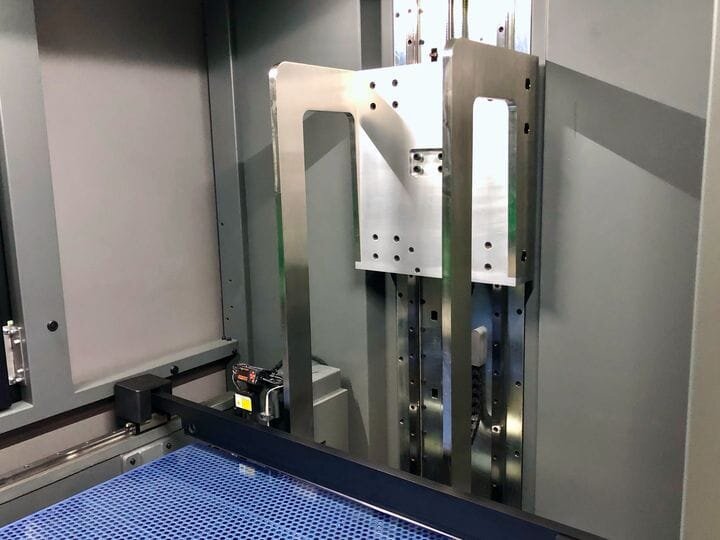![Very rigid components inside the RPS NEO 800 SLA 3D printer [Source: Fabbaloo]](https://fabbaloo.com/wp-content/uploads/2020/05/image-asset_img_5eb08de430376.jpg) Very rigid components inside the RPS NEO 800 SLA 3D printer [Source: Fabbaloo]
Very rigid components inside the RPS NEO 800 SLA 3D printer [Source: Fabbaloo]
I’ve learned the origin story of RPS, a UK-based manufacturing of SLA 3D printers.
The company produces a relatively large-format device known as the NEO 800, which uses the time-proven SLA process. A powerful laser sweeps through a tank of photopolymer resin to selectively solidify material, gradually building up a complete object layer-by-layer.
I’m always curious about how 3D printers companies start operations, as there usually is an interesting tale that reveals something unusual about the industry. In RPS’s case, that’s true.
The most typical origin story is that of a 3D printer operator who was dissatisfied with the printer they were using, and as a result ended up designing their own, and eventually selling it as a real product on its own.
That is not what happened at RPS. Their story is quite different.
3D Printer Service
It turns out that the folks behind RPS were into 3D Systems SLA equipment, and provided service and support to those using such gear. Typically these large industrial SLA machines required periodic maintenance that was provided through an annual maintenance contract.
This is where it gets interesting. It turns out that many of the clients receiving RPS service requested modifications to the 3D Systems equipment to improve it in one way or another. The machines could be made better through such modifications.
After seeing many such requests and observing patterns, RPS in 2012 made the enormous decision to try to make their own SLA 3D printer based on the nature of the modifications and their own thoughts on how an SLA 3D printer could be better designed.
In 2013 they were able to produce a working prototype of what would eventually become the NEO 800 device.
RPS 3D Printer Strategy
However, transforming from a service operation to one manufacturing end-user devices was quite a challenge. It was even more challenging to build a relatively low-volume but high quality machine, as that would be the only way to attract sales: the machine had to be better than the competition.
Their specific strategy was to make a better product through simplified design.
![Fan housing 3D printed on the RPS NEO 800 SLA 3D printer [Source: Fabbaloo]](https://fabbaloo.com/wp-content/uploads/2020/05/image-asset_img_5eb08de48b778.jpg)
One example of this strategy is evident in the NEO 800, which does not require any “convoluted” leveling procedures. The machine is instead simply made highly rigid at the factory and no such procedures are required.
Wait, how do they build a rigid frame? They’re actually using cast iron, an industrial material rarely seen in any 3D printer. That’s because cast iron is notoriously hard to CNC mill, and 3D printer manufacturers tend to avoid it. But somehow RPS figured out how to incorporate this highly rigid material into the NEO 800 design.
NEO 800 Design Features
But then there’s a bit of a chain reaction. Because the machine undergoes a one-time calibration and maintains that calibration from then onward, there is a decreased need for sensors in the production machine. If something isn’t able to move, then there is no reason to monitor it. This reduces the cost, and increases the reliability of the device.
![Very rigid components inside the RPS NEO 800 SLA 3D printer [Source: Fabbaloo]](https://fabbaloo.com/wp-content/uploads/2020/05/image-asset_img_5eb08de4cf36a.jpg)
RPS has decided to use a relatively low-power laser (2W) in the NEO 800. The reason for this decision is to lower the energy involved so that the laser will last longer. I’m told that lasers tend to gradually lose power, and at some point a laser’s lowered power will affect print quality. This effect is minimized in the NEO 800 due to their laser configuration.
The lower laser power means the machine requires only 6A of power, and no active cooling is required, further simplifying the design.
Similarly, the NEO 800 design eliminates blade maintenance, and there are other maintenance simplifications throughout the NEO 800 design. RPS says all these factors contribute to a lower cost of ownership for buyers.
Perhaps this is not surprising, given that RPS’s origin was in the service field providing maintenance to 3D printer owners.
The NEO 800 includes an on-board UPS to ensure operators when power is cut, and this again is helped by the relatively low power consumption of the device. The electronics in the NEO 800 are apparently military grade, and RPS says they have never had one fail.
NEO 800 Released
![Incredibly detailed surface texture 3D printed on the RPS NEO 800 SLA 3D printer [Source: Fabbaloo]](https://fabbaloo.com/wp-content/uploads/2020/05/image-asset_img_5eb08de53078b.jpg)
Finally, RPS was able to release the machine to the public in 2016, where it was well-received. We’re told by the company that many first time buyers have returned to purchase second units from RPS, which is always a good sign of a machine’s success.
RPS says they are currently selling the NEO 800 all over Europe, but then intend on opening sales in the USA soon. I get the impression they are looking for additional resellers, so if you happen to be a reseller seeking additional equipment options, you might want to give RPS a shout.
Via RPS

